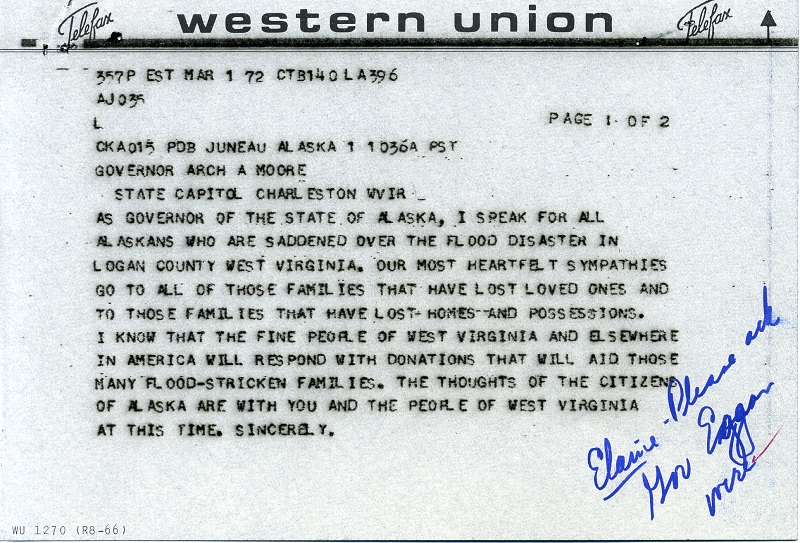Graduate Assistant Reflects on Buffalo Creek Disaster 50th Anniversary Archives and Exhibit
Posted by Admin.February 21st, 2022
By Crystal Coon
Early on the morning of February 26, 1972, a coal slurry impoundment on Buffalo Creek collapsed, sending millions of gallons of wastewater rushing into the valley below. Hundreds died or were injured, and thousands were left homeless. The cleanup, investigations, and lawsuits that followed further strained the community.
Located in Logan County, West Virginia, the Buffalo Creek Valley is a series of communities built upon the coal mining industry along the banks of a small stream known as Buffalo Creek. At 8 o’clock in the morning on that fateful day, Dam No. 3 failed, sending 132 million gallons of water careening down the Buffalo Creek Valley. It traveled in a twenty- to thirty-foot-high flood wave that moved at about seven feet per second. Within three hours, the wall of water had traveled over seventeen miles, and seventeen communities were partially or totally destroyed by the flood. In total, 118 people were killed in the flood, while seven were never accounted for after the disaster. There were 1,119 people who were physically injured by the floodwaters. Approximately 4,000 people were left homeless when 507 homes were destroyed, 273 homes were left with major damage, and 44 mobile homes were completely destroyed. Ten bridges were destroyed in the flood as well as hundreds of miles of roads and highways. The destruction left behind in the valley after the water receded would take years to recover from, physically, mentally, and emotionally.

Governor Moore created the Ad Hoc Commission of Inquiry into the Buffalo Creek Flood to investigate the reasons for the failure of Dam No. 3. The commission was charged with determining who was at fault for the collapse of the dam and the resulting loss of life and the destruction of property. The Commission gathered witnesses, heard testimonies, and talked to experts in the field of coal mining operations to best figure out why the tragedy occurred, who was responsible for it, and how it could be avoided in the future. In their conclusion, the Commission placed the blame on the parent company of Buffalo Mining Company but acknowledged that the lack of laws and regulations by the state and federal governments contributed to the failure of the dam.

On the 50th anniversary of the disaster, an online exhibit explores its history and implications for the present. The Buffalo Creek Disaster: 50 Years From Flooding is an online exhibit that showcases the disaster and aftermath of the devastating flood that hit Logan County in 1972. Curated from documents and photographs available through the West Virginia and Regional History Center, this exhibit focuses on the tragedy and recovery of the Buffalo Creek area. There is also an in-person exhibit that will be on display in the Downtown Library Atrium until December 2022. This exhibit will have some documents and photographs from the archives that show and discuss the disaster. During the spring semester, Mimi Pickering, filmmaker and director of “The Buffalo Creek Flood: An Act of Man,” will be hosting a virtual screening on her film at the Downtown Library. More information will be available as the event draws closer.

Having had the opportunity to sort through the papers from the Arch Moore administration about the disaster, I feel more connected to the event and the devastation that it left behind. Putting the exhibit together allowed me to sift through some of the more unseen side of the flood and people’s response to it. It gave me a deeper appreciation for the response of people all around the world when disaster strikes and they see other people in need. Seeing the letters, photographs, newspaper articles, disaster reports, and memos telling the governor of another body that was identified has allowed me to truly see even more meaning in the work that archives do in preserving emotion and memory.






February 28th, 2022 at 2:51 pm
Hi. I would like to know if my brother’s book can be included in the exhibit. Until his death in October 2021 he was still in communication with many of the folks he interviewed during his many visits to the area while doing research for the book.
After the Disaster: Re-creating Community and Well-Being at Buffalo Creek since the Notorious Coal-Mining Disaster in 1972 Kindle Edition
by Timothy Philip Schwartz-Barcott (Author)
Thank you so much for considering this. I look forward to your reply.
March 15th, 2022 at 8:20 am
Good morning, Denise. We appreciate your interest in this exhibit! The exhibit is already set up, but if you have any questions please reach out to us at (304) 293-3536.